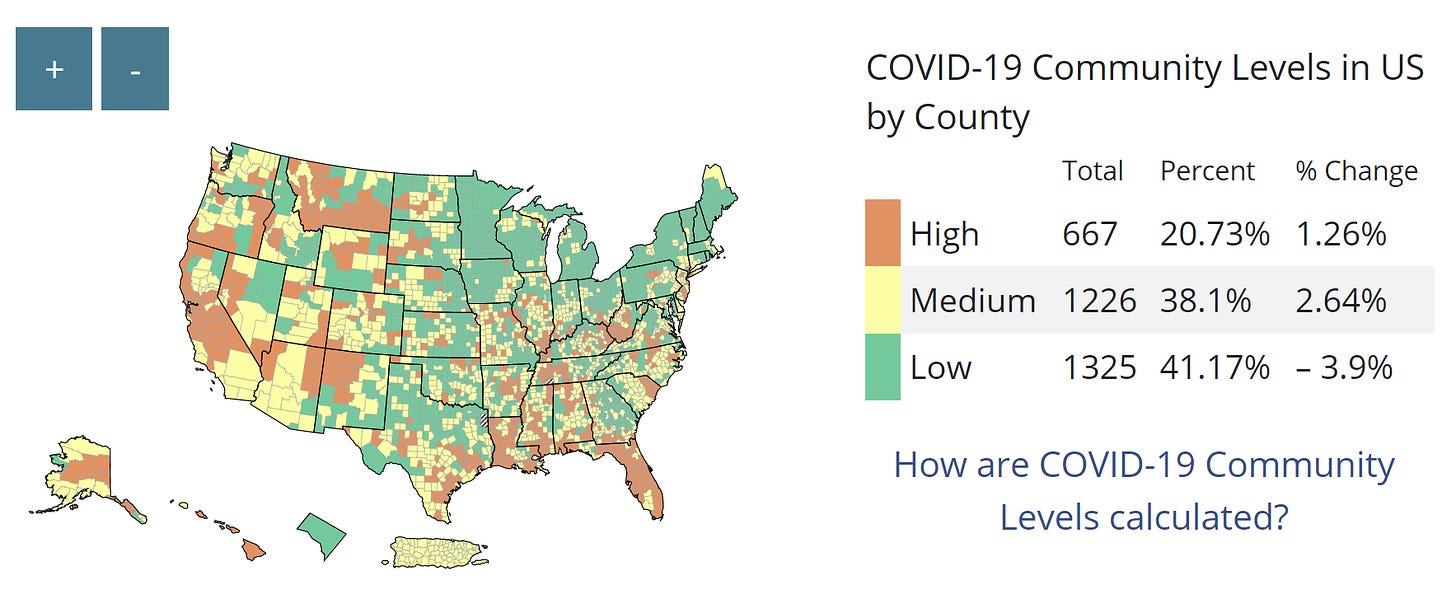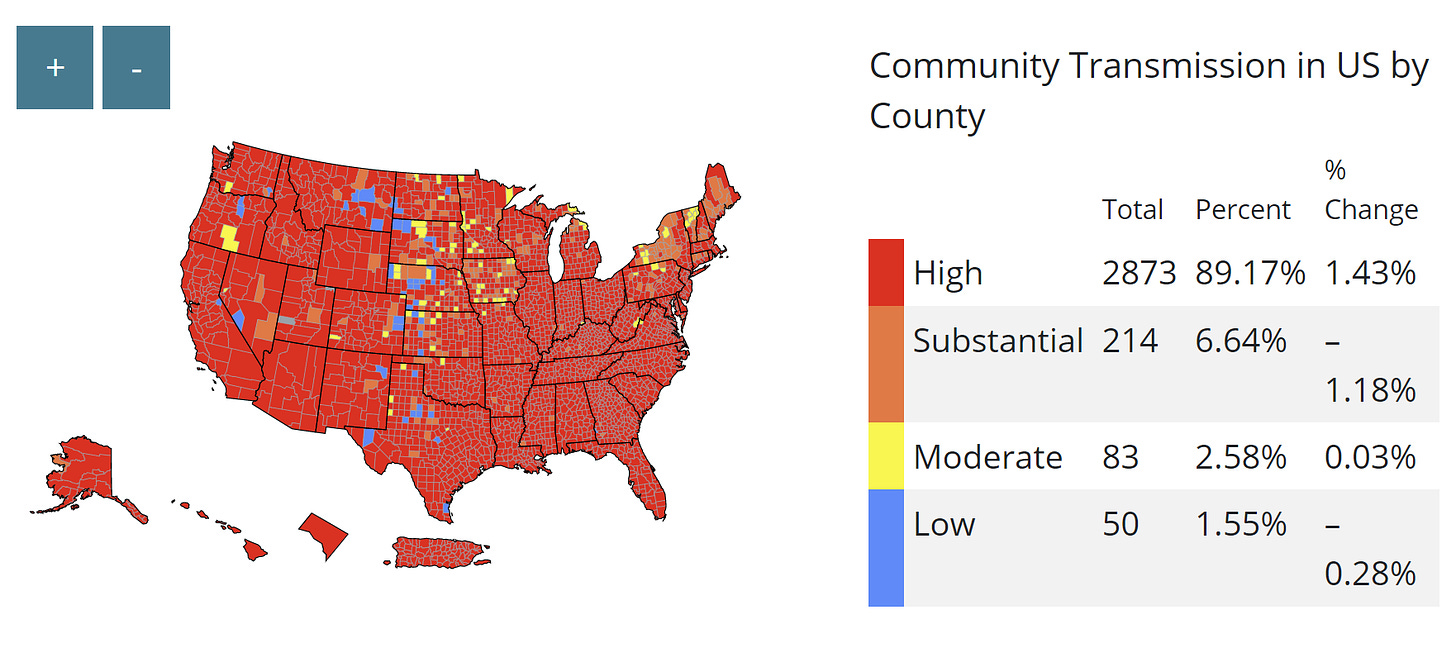BA.5 has arrived. An estimated 10-15% of Americans will be infected. Unfortunately, hospitalizations and death will follow, albeit at lower rates than we’ve seen before.
There are many reasons to avoid an infection (can’t miss work; don’t want to feel crappy for a week or two; risks of long COVID; high risk for severe disease; live with vulnerable people). But even if you do get infected, you can still help by stopping onward transmission.
Here are five ways we can safely ride this wave.
If you’re over 50 years old, get your booster.
If you don’t have your first booster, it’s beyond time. If you don’t have your second booster, get one now. Seriously. Schedule your appointment here. Do not delay. You will be able to get an Omicron booster this fall even if you get boosted now.
Another booster now will not only prevent infection but will prevent severe disease. In the U.S., adults aged 50 and older with two booster doses had 4 times lower risk of dying from COVID-19, compared to people who received one booster dose.
Those younger than 50 years will also soon be eligible for a second booster. If you have multiple comorbidities or work at a high exposure occupation, I think it makes sense to get a second booster now. If you’re young, healthy, and/or had a previous infection (hybrid immunity), it makes sense to wait for an Omicron booster in the fall. I, personally, will wait for my second booster. Keep in mind, protection against infection can be nil if it’s been a while since infection and/or last vaccination. You will especially need to have other layers of protection while waiting for that Omicron booster.
Take Paxlovid.
The next best tool for high risk people is Paxlovid. This is an oral anti-viral that is safe and incredibly effective against severe disease. (See more in previous post here.) You need to start the course within 5 days of symptom onset or it won’t work well. You can get a prescription from your clinician. The FDA also recently authorized getting a prescription directly from a pharmacist. Here are some test to treat location options.
Do not use the CDC community levels for masking.
To know when to wear a mask, don’t rely on the CDC Community Levels map. This tells us when to take collective action so the hospitals don’t surge. According to this map (first figure below), 21% of people should mask. This does not tell us when to wear a mask for individual protection. The old CDC transmission map is painted red (which doesn’t even take into account under-reporting) and shows 98% of Americans should wear a mask in crowded, indoor spaces if they don’t want to get sick. Transmission is high across the states and will get higher.
Increase ventilation.
Ventilation and filtration really matter and are powerful tools. This is especially important in the middle of a heat wave while people head indoors. The short video below gives a very clear depiction of how COVID19 spreads through the air. Think of SARS-CoV-2 as being like smoke. It can spread even if you’re just whispering and can linger for hours, even once someone has left the room. Get that air moving. You can use a CO2 monitor to know your ventilation, if that’s helpful.
Use antigen tests to break transmission chains.
At home antigen testing is one of the best tools we have right now to stop transmission. Antigen tests are free and can be ordered through the USPS site here.
If you have symptoms, there are a few things to keep in mind:
Antigen tests are great at detecting highly infectious people. You can expect the average antigen test to catch 78% to 97% of cases in the first week of symptoms.
False negatives are more common at the beginning of infection, especially with Omicron. If you have any symptoms, do not trust a negative test. Assume you have COVID19 and re-test in 24-48 hours. It will likely turn positive given the high transmission rates right now.
Antigen tests are very good at telling you when you’re not infectious anymore (very few false positives). If at all possible, leave isolation only once your antigen test is negative. We see strong evidence (here, here) that an Omicron infection lasts, on average, 8-10 days. Some people will be infectious for less, and some will be infectious for more. You won’t know unless you test. Some people can’t stay in isolation that long (need to work and/or employers won’t allow longer isolation, given the CDC guidance saying you can leave isolation after 5 days). If this is the case, wear a good mask once you leave isolation.
If you take Paxlovid, an estimated 5-10% people rebound. (Read more about rebounding here.) If you test negative after Paxlovid, continue to test for another couple of days. If you turn positive again, assume you’re infectious again until you turn negative.
If you use antigen tests before seeing someone vulnerable, keep the following in mind:
If you have the virus and are asymptomatic, you can expect the average antigen test to catch 44% to 70% of cases. This is good but not perfect.
Be sure to conduct cadence testing: test 48 hours before the event and again the morning of. If they are both negative, I would feel comfortable proceeding.
Bottom line
There are many things we can do to protect ourselves and those around us while we ride the BA.5 wave out. Please leverage these tools. They will, no doubt, help.
Love, YLE
“Your Local Epidemiologist (YLE)” is written by Dr. Katelyn Jetelina, MPH PhD—an epidemiologist, biostatistician, wife, and mom of two little girls. During the day she works at a nonpartisan health policy think tank, and at night she writes this newsletter. Her main goal is to “translate” the ever-evolving public health science so that people will be well equipped to make evidence-based decisions. This newsletter is free thanks to the generous support of fellow YLE community members. To support the effort, please subscribe here:








Thanks for this! Curious about your advice re: delaying 2nd booster for those under 50. How soon before those of us in our 40s are eligible for a 2nd booster? You say Over 50 should get 2nd booster now and they will still be able to get Omicron booster in the fall. Is that because the Omicron booster won’t be available for 5+ months and so if you get a booster NOW you’ll be eligible again by then? But because Under 50 won’t be eligible for another month or more their window won’t be open again in time for the Omicron booster when it first arrives? I’m trying to figure out just how long I’ll be feeling like a sitting duck. I’m in my 40s and healthy but it’s been 8 months since my 1st booster…
Thanks for the update!
Hoping you will cover Novavax soon? Some folks on Twitter are very high on it due to “no signs of waning” and “protection to all variants”.
As someone who has had 2x Pfizer and a Moderna booster and never infected, I’m highly considering that as my next course (because I want to avoid getting C19 ever) but haven’t seen the data to support the above claims.